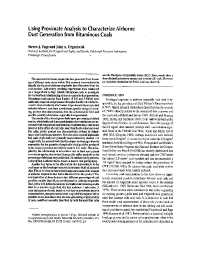Mining Publication: Using Proximate Analysis to Characterize Airborne Dust Generation from Bituminous Coals
Original creation date: June 2002
The amount of airborne respirable dust generated from breakage of different coals varies widely. This research was conducted to identify the facets of airborne respirable dust liberation from the coal product. Laboratory crushing experiments were conducted on a range of low to high volatile bituminous coals to investigate the various factors influencing airborne respirable dust generation. Bituminous coal samples from eight mines (five U.S. and three Polish) were uniformly prepared and processed through a double roll crusher located in a low air velocity wind tunnel. Experimental factors studied included inherent coal seam constituents, specific energy of crushing, product size characteristics, dust cloud electrostatic field, and specific quantity of airborne respirable dust generated. The results of this investigation build upon previously published results which indicated that a combination of several factors are associated with the generation of airborne respirable dust. One factor involved is the effect of coal rank, described by the inherent moist fuel ratio, on the product size characteristics, defined by Schuhmann size function parameters. However, since coals of high moist fuel ratio (high rank) are generally more extensively cleated, it is suggested in the present work that the degree of cleating is directly responsible for the quantity of respirable-sized particles produced in the crushed product material for eastern U.S. coals. This is implied by the relationship of ash content and at least one mineral constituent (pyrite, determined from pyretic sulfur analysis) with the percentage of airborne respirable dust. To validate this hypothesis, a description is offered which is based on known coal petrography. Another key factor of the effect of air dry loss moisture in the coal seam on the breakage-induced electrostatic field of airborne dust. The air dry loss moisture factor appears to control the amount of airborne respirable dust that is liberated from the product. The resultant effect of these factors is that different percentages of coal particles smaller than 10 mm are dispersed as airborne respirable dust, with a well-defined peak in the normalized airborne respirable dust for a narrow range of air dry loss moisture )ash ratios. A clear delineation of coals, based on well-known proximate analysis characteristics, which generate the most respirable dust appears possible. It was also shown that the dust-generating characteristics of coals could be reasonable described by both the moist fuel ratio and the HGI. These results show a clear distinction between the eastern and western U.S. coals. However, no consistent distinction for the Polish coals were observed.
Authors: SJ Page, JA Organiscak
Peer Reviewed Journal Article - June 2002
NIOSHTIC2 Number: 20023506
Aerosol Sci Tech 2002 Jun; 36(6):721-733
See Also
- Dust Considerations When Using Belt Entry Air to Ventilate Work Areas
- The Effects of Water Spray Placement for Controlling Respirable Dust and Face Methane Concentrations
- Equivalency of a Personal Dust Monitor to the Current United States Coal Mine Respirable Dust Sampler
- Investigation of Coal Properties and Airborne Respirable Dust Generation
- Laboratory Evaluation of Pressure Differential-based Respirable Dust Detector Tube
- Laboratory Testing To Quantify Dust Entrainment During Shield Advance
- New Tools To Monitor Personal Exposure To Respirable Coal Mine Dust
- Performance of a Light Scattering Dust Monitor at Various Air Velocities: Results of Sampling in the Active Versus the Passive Mode
- Relationship of Coal Seam Parameters and Airborne Respirable Dust at Longwalls
- Using Ventilation Control Technology to Reduce Respirable Dust Exposures at U.S. Metal/Nonmetal Mining Operations
- Content source: National Institute for Occupational Safety and Health, Mining Program


 ShareCompartir
ShareCompartir
